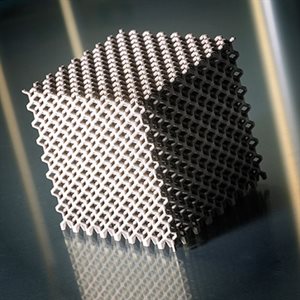Additive manufacturing (AM) or additive layer manufacturing (ALM) is the industrial production name for 3D printing, a computer controlled process that creates three dimensional objects by depositing materials, usually in layers.

Contents
Click the links below to skip down to a section in the guide:
Using computer aided design (CAD) or 3D object scanners, additive manufacturing allows for the creation of objects with precise geometric shapes. These are built layer by layer, as with a 3D printing process, which is in contrast to traditional manufacturing that often requires machining or other techniques to remove surplus material.
There are number of distinct AM processes with their own standards, which include:
This technique uses a 3d printing style head moving on x, y and z axes to deposit alternating layers of powdered material and a liquid binder as an adhesive.
Read more
Direct energy deposition additive manufacturing can be used with a wide variety of materials including ceramics, metals and polymers. A laser, electric arc or an electron beam gun mounted on an arm moves horizontally melting wire, filament feedstock or powder to build up material as a bed moves vertically.
Read more
This common AM process uses spooled polymers which are either extruded or drawn through a heated nozzle which is mounted on a movable arm. This builds melted material layer by layer as the nozzle moves horizontally and the bed moves vertically. The layers adhere through temperature control or chemical bonding agents.
Read more
Powder bed fusion encompasses a variety of AM techniques including direct metal laser melting (DMLM), direct metal laser sintering (DMLS), electron beam melting (EBM), selective laser sintering (SLS) and selective heat sintering (SHS). Electron beams, lasers or thermal print heads are used to melt or partially melt fine layers of material after which excess powder is blasted away.
Read more
Sheet lamination can be split into two technologies; laminated object manufacturing (LOM) and ultrasonic additive manufacturing (UAM). Laminated object manufacturing is suited to creating items with visual or aesthetic appeal and uses alternate layers of paper and adhesive. UAM uses ultrasonic welding to join thin metal sheets; a low energy, low temperature process, UAM can be used with various metals such as aluminium, stainless steel and titanium.
This process uses a vat of liquid resin photopolymer to create an object layer by layer. Mirrors are used to direct ultraviolet light which cures the successive layers of resin through photopolymerisation.
Wire arc additive manufacturing uses arc welding power sources and manipulators to build 3D shapes through arc deposition. This process commonly uses wire as a material source and follows a predetermined path to create the desired shape. This method of additive manufacture is usually performed using robotic welding equipment.
AM technologies can be broadly divided into three types.
The first of which is sintering whereby the material is heated without being liquified to create complex high resolution objects. Direct metal laser sintering uses metal powder whereas selective laser sintering uses a laser on thermoplastic powders so that the particles stick together.
The second AM technology fully melts the materials, this includes direct laser metal sintering which uses a laser to melt layers of metal powder and electron beam melting, which uses electron beams to melt the powders.
The third broad type of technology is stereolithography, which uses a process called photopolymerisation, whereby an ultraviolet laser is fired into a vat of photopolymer resin to create torque-resistant ceramic parts able to endure extreme temperatures.